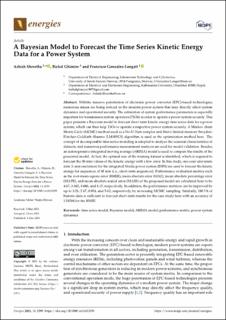| dc.description.abstract | With the massive penetration of electronic power converter (EPC)-based technologies, numerous issues are being noticed in the modern power system that may directly affect system dynamics and operational security. The estimation of system performance parameters is especially important for transmission system operators (TSOs) in order to operate a power system securely. This paper presents a Bayesian model to forecast short-term kinetic energy time series data for a power system, which can thus help TSOs to operate a respective power system securely. A Markov chain Monte Carlo (MCMC) method used as a No-U-Turn sampler and Stan’s limited-memory Broyden– Fletcher–Goldfarb–Shanno (LM-BFGS) algorithm is used as the optimization method here. The concept of decomposable time series modeling is adopted to analyze the seasonal characteristics of datasets, and numerous performance measurement matrices are used for model validation. Besides, an autoregressive integrated moving average (ARIMA) model is used to compare the results of the presented model. At last, the optimal size of the training dataset is identified, which is required to forecast the 30-min values of the kinetic energy with a low error. In this study, one-year univariate data (1-min resolution) for the integrated Nordic power system (INPS) are used to forecast the kinetic energy for sequences of 30 min (i.e., short-term sequences). Performance evaluation metrics such as the root-mean-square error (RMSE), mean absolute error (MAE), mean absolute percentage error (MAPE), and mean absolute scaled error (MASE) of the proposed model are calculated here to be 4.67, 3.865, 0.048, and 8.15, respectively. In addition, the performance matrices can be improved by up to 3.28, 2.67, 0.034, and 5.62, respectively, by increasing MCMC sampling. Similarly, 180.5 h of historic data is sufficient to forecast short-term results for the case study here with an accuracy of 1.54504 for the RMSE. | en_US |

